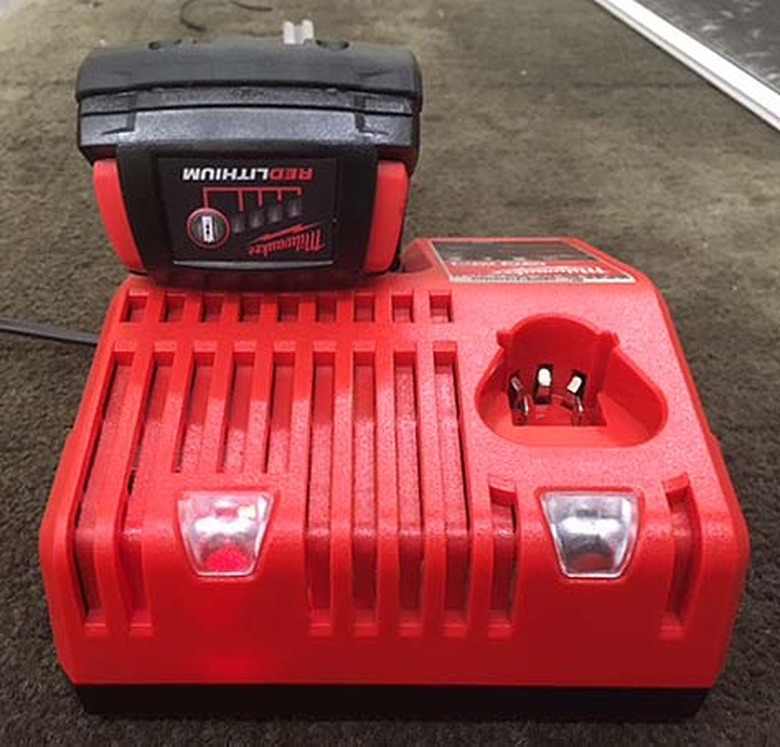How To Troubleshoot A Power Tool Battery That Won't Charge
The Milwaukee brand used to supply rechargeable nickel-cadmium batteries for its line of battery-powered tools, but like most manufacturers, it has gradually phased these out in favor of lithium-ion batteries. Current Milwaukee chargers, like those produced by other manufacturers–including Ryobi, Bosch, Makita and deWalt–have flashing lights that tell you when a battery is charged, when one is too hot to charge and when one is defective. A worn out battery won't charge, but you may be able to give it new life–at least temporarily.
Milwaukee Chargers, an Overview
If you have a charger for 18V Milwaukee lithium-ion batteries, that's the only type of battery you should attempt to charge with that charger. Milwaukee manufactures a separate charger for its 12V batteries. And, of course, batteries from other manufacturers won't fit on a Milwaukee charger.
The charger has bays for both its clip-on and stem batteries. When you insert a battery for charging, a red LED comes on and burns steadily until the battery is charged. When the charge is complete, a green light comes on and burns steadily.
What Do the Flashing Lights Mean? The charger might display one of two warning signals when you insert a battery, and as long as these are displayed, the battery won't begin to charge. The first, a flashing red light, means the battery is too hot to charge. When you see this, remove the battery; let it cool down, and try again later.
The second warning–a flashing red and green light–could mean the battery wasn't inserted properly, but if you're sure it's properly seated, the warning can also mean that the battery is defective. Remove it, and clean the terminals on the battery with alcohol. Then unplug the charger and clean the terminals inside the charger port. If you still see the red and green warning, you've got a problem with that battery.
Jump-Starting Your 18V Lithium-Ion Battery
If you see the red and green flashing light, and you're sure the battery is properly inserted and the connections are clean, the battery is probably dead–but you may be able to shock it back to life. It's a simple trick, but it isn't recommended by the manufacturer, which recommends instead calling a service representative or getting a new battery.
Here's the hack: Place the dead battery on the table next to a good one that is fully charged. Connect the corresponding terminals on each battery to each other with 14-gauge copper wire. Tape the wire to the terminals, and wait for one or two minutes. When you remove the wires and insert the battery in the charger, it should start charging. This doesn't mean the battery is as good as new. The charge may not last as long as that of a new one, but you'll probably get several more cycles out of the battery before you really have to throw it away.
Tip
If you don't see any lights when you insert the battery, check the plug. It may be plugged into a GFCI outlet that has tripped, or the circuit breaker may have tripped. If the plug is working, you probably need to replace a fuse in the charger itself.
Resetting the Memory in a Nickel-Cadmium Battery
The charger for older Milwaukee NiCad batteries has a single red LED light. After inserting a battery, a solid light indicates the battery is charging normally, and a flashing light indicates a problem — usually that the battery is too hot to charge. If you continue to see the flashing light after allowing the battery to cool, the battery is probably defective.
You can reset the memory in a NiCad battery so that it will again hold a charge, but you need a larger power source, such as a 12V car battery. Attach jumper cables to the 12V battery–red to the positive terminal and black to the negative. Touch the end of the red cable to the NiCad battery's positive terminal and the black cable to the negative one for a second or two. The power surge clears the sulfates that have accumulated inside the battery and restores the battery.
Warning
Wear protective gloves and goggles. The cables are likely to spark when you touch them to the battery terminals.
